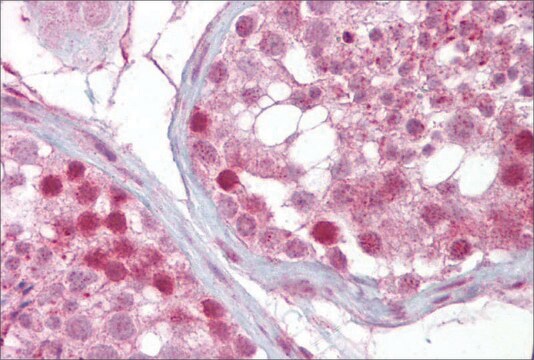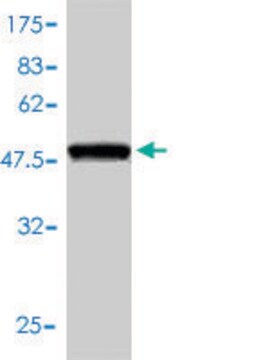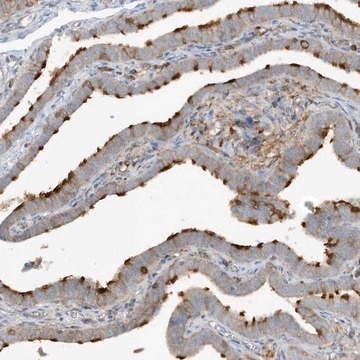ABC932
Anti-IFT88 Antibody
serum, from rabbit
Synonym(s):
Intraflagellar transport protein 88 homolog, Polaris, Recessive polycystic kidney disease protein Tg737, Tetratricopeptide repeat protein 10, TgN(Imorpk)737Rpw, TPR repeat protein 10
About This Item
Recommended Products
biological source
rabbit
Quality Level
antibody form
serum
antibody product type
primary antibodies
clone
polyclonal
species reactivity
rat, human, mouse
species reactivity (predicted by homology)
bovine (based on 100% sequence homology)
technique(s)
electron microscopy: suitable
immunocytochemistry: suitable
immunofluorescence: suitable
western blot: suitable
NCBI accession no.
UniProt accession no.
shipped in
dry ice
target post-translational modification
unmodified
Gene Information
bovine ... Ift88(514177)
human ... IFT88(8100)
mouse ... Ift88(21821)
rat ... Ift88(305918)
General description
Specificity
Immunogen
Application
Western Blotting Analysis: A representative lot detected a greatly reduced Tg737/Polaris expression in lysate from E11.5 mouse embryo limbs with conditional mesenchymal Ift88-knockout (prx1cre;Ift88fl/n) when compared with lysate from a wild-type littermate (Haycraft, C.J., et al. (2007). Development. 134(2):307-316).
Immunocytochemistry Analysis: A representative lot detected IFT88 (Tg737/Polaris) cellular localization in paraformaldehyde-fixed rat and murine sperm cells, rat round spermatids, as well as elongating spermatids from Ift88 mutant mice (Kierszenbaum, A.L., et al. (2011). Dev. Dyn. 240(3):723-736).
Immunocytochemistry Analysis: A representative lot detected Tg737/Polaris immunoreactivity associated with the cilium of cultured limb bud cells isolated from wild-type mouse E11.5 embryos by fluorescent immunocytochemistry, while cilia were absent in cells from Tg737Δ2–3β-gal embryos (Haycraft, C.J., et al. (2005). PLoS Genet. 1(4):e53).
Electron Microscopy Analysis: A representative lot detected IFT88 (Tg737/Polaris) localization in rat round spermatids and fractionated manchettes (Kierszenbaum, A.L., et al. (2011). Dev. Dyn. 240(3):723-736).
Immunofluorescence Analysis: A representative lot detected polaris immunoreactivity in both dental epithelium (DE) and dental mesenchyme (DM) of lower molar frontal sections from E13.5 and E16.5 embryonic mice (Ohazama, A., et al. (2009). Development. 136(6):897-903).
Immunofluorescence Analysis: A representative lot immunostained primary cilium on epithelial and mesenchymal cells of the skin and hair follicle using OCT-embedded frozen skin sections from both mouse embryos and adult mice (Lehman, J.M., et al. (2009). J. Invest. Dermatol. 129(2):438-448).
Immunofluorescence Analysis: A representative lot detected Ift88 (Tg737/Polaris) immunoreactivity enriched at the base and tip of the hair cell (HC) kinocilia in the ciliary axonemes by fluorescent immunohistochemistry using 4% paraformaldehyde-fixed inner ear cochlear whole mounts prepared from mouse E14.5 embryos (Jones, C., et al. (2008). Nat. Genet. 40(1):69-77).
Immunofluorescence Analysis: A representative lot immunostained cilium in mesenchymal and ectodermal cells in formaldehye-fixed, OCT-embedded frozen limb bud sections from mouse E11.5 embryos by fluorescent immunohistochemistry. Conditional mesenchymal Ift88-knockout (prx1cre;Ift88fl/n) selectively abolished Tg737/Polaris immunoreactivity in the mesenchyme, but not the ectoderm layer (Haycraft, C.J., et al. (2007). Development. 134(2):307-316).
Immunofluorescence Analysis: A representative lot detected Tg737/Polaris immunoreactivity at the base and distal tip of cilium in mesenchymal and ectodermal cells in OCT-embedded frozen limb bud sections from mouse E10.5 embryos by fluorescent immunohistochemistry (Haycraft, C.J., et al. (2005). PLoS Genet. 1(4):e53).
Apoptosis & Cancer
Developmental Signaling
Quality
Western Blotting Analysis: A 1:200 dilution of this antibody detected IFT88 in 50 µg of mouse kidney tissue lysate.
Target description
Physical form
Storage and Stability
Handling Recommendations: Upon receipt and prior to removing the cap, centrifuge the vial and gently mix the solution. Aliquot into microcentrifuge tubes and store at -20°C. Avoid repeated freeze/thaw cycles, which may damage IgG and affect product performance.
Other Notes
Disclaimer
Not finding the right product?
Try our Product Selector Tool.
Storage Class Code
12 - Non Combustible Liquids
WGK
WGK 1
Flash Point(F)
Not applicable
Flash Point(C)
Not applicable
Regulatory Listings
Regulatory Listings are mainly provided for chemical products. Only limited information can be provided here for non-chemical products. No entry means none of the components are listed. It is the user’s obligation to ensure the safe and legal use of the product.
JAN Code
ABC932:
Certificates of Analysis (COA)
Search for Certificates of Analysis (COA) by entering the products Lot/Batch Number. Lot and Batch Numbers can be found on a product’s label following the words ‘Lot’ or ‘Batch’.
Already Own This Product?
Find documentation for the products that you have recently purchased in the Document Library.
Our team of scientists has experience in all areas of research including Life Science, Material Science, Chemical Synthesis, Chromatography, Analytical and many others.
Contact Technical Service








